- Friday, July 26, 2024
Swami Brahmaviharidas on how HH Pramukh Swami Maharaj inspired Akshardham Temple

By: SHAILESH R SOLANKI
SWAMI BRAHMAVIHARIDAS is one of the most respected and admired of Swaminarayan figures who lead the global organisation that is BAPS today. He has led the project to build the spectacular Akshardham Temple in Abu Dhabi since its conception. In this exclusive and very special interview with Shailesh R Solanki, executive editor, Asian Media Group, he talks about his unique calling, his relationship with his guru, His Holiness Pramukh Swami Maharaj who inspired the temple and how prime minister Narendra Modi helped make the project a reality…
Shailesh Solanki (SS): As you may know my father (Ramniklal Solanki CBE) produced a commemorative supplement when Pujya Yogiji Maharaj came to the UK in 1970. Do you have any personal recollections of Pujya Yogiji Maharaj?
Brahmavihari Swamiji (BS): I was not fortunate as a child to have met Yogiji Maharaj but I did hear a lot of stories. In the indirect experiences that I’ve had, he was the most innocent sadhu or a spiritual person you could ever imagine, and a person whose love actually embraced everybody. A great spiritual leader who was always engaged in the worship and meditation of God.
I would like to recollect a small incident to tell you why I say this. Once in Ahmedabad, we had to go and meet a very senior legal person. As our rickshaw went to somebody’s home, his name was exactly the same as the person I wanted to meet. That man invited us, we sat, very quietly, and embarrassingly, I told our volunteer, ‘I think we’re at the wrong house’, because it’s not him. My volunteer said, ‘but Swami, it’s the same name’. I said, ‘it’s the same name, but I have seen him before, and it’s not him’. So how do you tell somebody who has welcomed you, who is so happy about you coming there, that sorry, we’re at the wrong house?
After about a half an hour discussion, I very politely brought up the issue and said, ‘sir please forgive me. You are a big lawyer yourself. But we were actually at the wrong house. We wanted to see somebody else’. He said, ‘no, no, Swamiji, you are at the right home’. And I said, ‘why?’
He said, ‘I want to explain to you that about 50 years ago, I was a very young lawyer and had come into Ahmedabad. I used to stay at Akshar colony and that’s where a saint like Yogiji Maharaj was seated. Because I was a young kid, I was not a swamy, I was not interested. Yogiji Maharaj was doing his puja in his room alone, and as I was passing by – my staircase actually led to that room – I saw for a second he was so engrossed in God. I thought that not all the human beings on this earth together could extricate him from his connection to God. That’s my only image and impression of Yogiji Maharaj. Since then, I have only got one image in my small puja room where I meditate for two-three hours, it’s of Yogiji Maharaj. I have not met any swamis and sadhus till now because I’m not a Swaminarayan [believer]. I’m not even so religious. But that moment was so deep in my heart, I used to pray to Yogiji Maharaj, that if you are true, one day, you bring the saints of your Sampradaya to my home unannounced. So now I believe that it’s him. Yes, it’s him who had actually guided you here. So you are at the right home’.
This is why I say that my impression and feelings for Yogiji Maharaj are way out of this world.
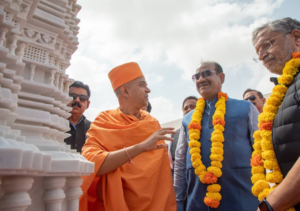
SS: It’s a beautiful story. My father often spoke about the innate divinity and spirituality of Pujya Pramukh Swami Maharaj, and you were ordained by him in 1981. Can you tell us what Pujya Pramukh Swami meant to you?
BS: Everything. I really want to say that whatever I am, whatever my emotions, whatever my thoughts, and whatever the goodness that he has inspired me to follow, everything is Pramukh Swami for me. I would like to explain in a very simple way that does not confuse anybody. The photograph of your child is not your child. It’s some piece of paper. When you look at that photograph, you can think of nobody else but your child. Similarly, your wedding ring is not your wife. When you have a wedding ring on your finger, and you look at that, you can think of nobody else but your wife. Similarly, when I look at Pramukh Swami, he’s not God. But when I look at him, it’s pure spirituality and I think of nobody else, but God. So, Pramukh Swami is very special. It just begins with him, and it embraces everything that I see.
SS: You were a very brilliant student and got grades to go to Oxbridge or LSE. What then inspired you to join the Sanstha?
BS: There are so many things in anybody’s life, some things you can explain, but there’s a lot more you can’t. Some things you can connect the dots backwards, and some things you try and connect the dots in the present. So, if I look at my life, in hindsight, at that time, I had just finished my O levels, I was doing my A levels, and about to sit my S papers (common for Oxbridge entrants). And your grades are predicted. That was the time. But my connection with Swami really was one of the sources of inspiration. We had this adhiveshan (meeting). And the finals of this adhiveshan mean all these competitions which are arranged by elders for children – essay writing, drawing, speech, narration, and then table tennis and sports. I participated from Leicester. I was just about 11 or 12 at the time. I was very new, even in the spiritual way because we were very young. And in the adhiveshan, by God’s grace, I won quite a few prizes.
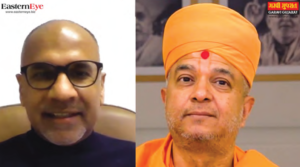
The final ceremony was at Wembley Conference Centre and all the kids were gathered there. And to my surprise, I won the best balak shield. This was in 1977. When I went to collect it from the hands of Pramukh Swami, it is a big shield and in the excitement, I dropped the shield, and a little part of the shield broke. I was quiet, not just embarrassed, but a little hurt and unhappy, but the people were all applauding because I had won it. Carrying the little part that was broken, I went down the stage, and as I was about to sit down in my chair, a special seat was offered because I won the prize.
At that time, the organisers came to me and said, ‘can we have that shield back’? As a child, you don’t give anything that you have, and definitely not a prize. So I started saying, no, no. He said, ‘that Swami on the stage, – I was not so familiar with everything at that time – he has said that you are hurt because the shield is broken. So we will replace the shield’.
I was so stunned. While everybody thought I was happy, how did he know that I was hurt? Pramukh Swami. So that same evening, I wrote a letter in English, that, ‘Swami, while everybody was applauding, and they thought I was happy, how did you know that I was a little hurt?’
To my surprise, I got an answer back. This is the beauty of Pramukh Swami. In the answer, he wrote to me, that ‘amne Angreji avadtu nathi, tu Gujarati sikhine kagal lakhje (I don’t understand English, you learn Gujarati and write me a letter). And I went down to my dad and said, ‘I want to learn Gujarati’ and everybody was thinking, why learn Gujarati and things like that. At that time, on Halkin Street in Leicester, there was a Gujarati class going on every Sunday, after the bal sabha (children’s assembly). I became a regular bal sabha person. And then slowly, as I got interested, my connection started to grow.
I was always amazed by Pramukh Swami. I felt he read me through and through, and it was a deep connection. I was always guided by him, and I was definitely inspired by him as a person, because I did not know much about the life of a monk. As I got close to him, I did decide that I wanted to be sadhu. So many people wondered, because there’s good scope in education and oth er things. One of my school teachers said, ‘I knew you’d do something stupid like this’! I just want to tell you honestly that those people now feel completely satisfied, saying yes. In our organisation, nobody can become a monk without the willing permission of your father and mother, and your family members. That’s when Pramukh Swami would accept you.
So that was my inspiring single incident, which was like he knew me. That was very, very inspiring, and continues to inspire me even now. You feel that there’s somebody who understands you, knows you, and reads you.
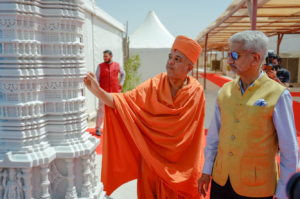
SS: You said in a previous interview that the Abu Dhabi Mandir was Pujya Pramukh Swami’s prophetic vision for global harmony. Can you speak about his vision for this mandir and how it was conceptualised?
BS: In all honesty, at that time in 1997, we were all in Dubai, and we were advised that ‘whatever you do, any spiritual gathering or talking to the devotees, you should do privately. Please do not do anything in public’. Because at that time, that was the atmosphere, and maybe that was what was required. It was also unthinkable even of going to Abu Dhabi in these clothes. Not because there were like strict laws or something like that, but that was how everything was perceived.
So we were all there quietly, doing our puja and all our ceremonies very quietly, privately, in our devotees’ homes. Once or twice, we did the assembly in the Indian embassy. At that time, we thought that it would be a good idea to go to Sharjah, and in the deserts of Sharjah, suddenly there was a sandstorm. Everybody was protecting themselves and Pramukh Swami was under an umbrella. Out of the blue Pramukh Swami started praying. And as his habit is, he started doing this dhun, Swaminarayan, Swaminarayan, Swaminarayan, and then dhun for goodness, and even some works which are incomplete may they be completed without any hindrance and things like that.
That is customary. Here it was suddenly surprising. And if I link it with London, this is something else that is very important. I told Swami that ‘when Yogiji Maharaj came to London in 1970, and he was being carried in the special chair, he suddenly told everybody that ‘please put me down, don’t you want me to touch the bhoomi of England with my foot’. I also said, ‘Bapa, this is in the desert, we are in Dubai. Why don’t you take your footwear off, and then put your toe and your foot exactly in the sand, like Yogiji Maharaj did in London’. So this is a small connection.
And Pramukh Swami was doing dhun and suddenly out of the blue, he said, ‘may there be a temple in Abu Dhabi’. We were all surprised, like struck by wonder. And he continued, ‘may it bring countries, cultures, communities and religions closer together’. And then he said, may every country grow, without any internal enmity, free of prejudice, and progress in their own unique way. Darek desho potani reete pragati kare, ver jeher thi dur thay.
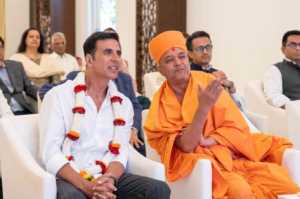
All those things he said, doing dhun, and we all joined in. But at that time, I felt this was almost like wishful thinking. But I did take a pinch of sand where he had stood. I don’t know why I did that, and it’s still surprising. I kept that sand in my puja; its still here today, after so many years. But it wasn’t like there will be a temple and it almost became like a fun line. Every time something is impossible or unthinkable, you say Swami apne Abu Dhabi ka mandir hain! But now, as we look at it, it’s happening. It’s all happened. Only to say that whatever he has said, it’s come true.
SS: So when you took that pinch of sand, it seems that it was preordained that you would lead this project as envisioned by Pujya Pramukh Swamiji?
BS: Now you can connect the dots in that way. But I don’t know why I took it. Rohitbhai Patel and Yogicharan Swami also took that pinch. But unfortunately, both of them are no more. So I’m the only one with that pinch of sand. And it feels very different even now. So yes, maybe so.
SS: What do you think the significance of building a traditional Hindu mandir in the Middle East is? Tell us a little bit about the hurdles you faced.
BS: I will not call them hurdles. When you walk into complete new terrains, when you walk the path that nobody has ever walked, everything becomes a challenge. Not because the path challenges you, but because of uncertainties and the strangeness. If I put it in a better way – you can eat here, smile here, and walk here and I will put you on the moon, then everything is a challenge. The simplest things.
I never had it in my mind that because Pramukh Swami has said that, let’s go and build a mandir. There was no strategy or anything like that. We went to the Royal Majlis once, because there was some issue with the villa where we used to gather for every Friday assembly. We got a notice because, technically, you’re not supposed to do any religious activities in any residential area. And that’s fair. Pramukh Swami always encouraged every devotee, the entire organisation, to respect the host country, to follow the law to the letter, and to just be gentle and polite and try and find a way if there is a way. So in that line, I’ve gone down to meet any royal family member that we could.
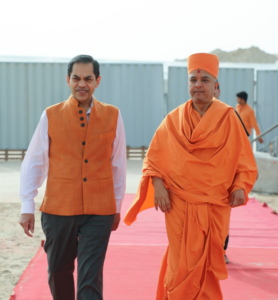
This was in 2013. Almost 1000 good people said, ‘Swami there can’t be a temple here’. And they were saying it in all fairness. But as I went down to understand what had happened, I connected with the royal family members, particularly based on our conversations, which circled around Hinduism, what the sadhus’ life is, who we were. The sheikhs were very happy and understanding. And as I explained what has happened and what we are doing, they suggested, ‘why don’t you write a letter to the crown prince of Abu Dhabi for a place for a temple?’
I was so surprised. It’s like you’re working for something and you end up with something else. I was so naive at that time. I wrote a letter to the crown prince of Abu Dhabi, for place in Dubai. And, again, so many wise people said, ‘Swami if you want to do spiritual activities, then just write that you want a meditation centre or, a spiritual centre, but don’t write the word temple’. So, when I went to Pramukh Swami, he was 93 at the time, I asked him, ‘Swami, this is what we have been told, what should we do, if we do get a place’.
Swami said, ‘what’s in your heart? If a temple is in your heart, be truthful and write that’. I said, ‘but the temples will have murthis and how it will be looked upon, what should we do’. He told me something very important. He said, ‘what begins with the lie, ends up with a lie. And what is founded on truth, glorifies truth. Truth is the essence of life’. And he explained that the higher people evolve, the more they respect truth and honesty. So he said, ‘be truthful, that you want a place for a temple’. And we did.
That was the historic year 2013. Very informally, we got an answer back that, ‘yes, you will get a piece of land in Abu Dhabi’. There was no temple in Abu Dhabi at that time, as well. There were people who said that maybe this is the beginning, but maybe it will not happen.
Then Narendra Modi became the prime minister. He knew that we had earlier conversations about the temple. But nothing was actually happening. The response we got was one of so much friendship and kindness, so we were hopeful. Then, after two years in 2015, when the prime minister came on his official visit to the UAE, he and the crown prince, His Highness Sheikh Mohammed bin Zayed Al Nahyan, they met, and I think the friendship that they share, and the trust that generated has not just brought countries together, and the people of those countries together and has not just ended up in great trade and agreements, but it’s grown to a level where a mandir was technically allotted land!
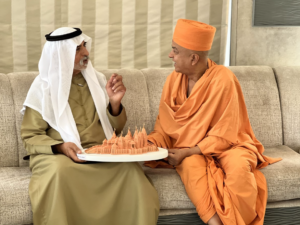
You might ask what’s happened then from 2015 to 2018? In the government system, they needed enabling clauses because this was the first. The officers came and saw the London Mandir, and then he sent his brother, His Highness Sheikh Abdullah bin Zayed Al Nahyan, to Akshardham Delhi. So they saw the mandir, with all the features. And in 2018, when our prime minister came again, and met the crown prince in the presidential palace, we were there. When we spoke to both of them together, His Highness said that if it’s a temple, it should look like a temple, make a traditional temple.
We had two options. One, the non-traditional, contemporary temple, which is like a normal building from outside, and the other the stone temple, which has a lot of carving that actually revives 10,000 years of art, and is absolutely traditional. So when they selected that, the prime minister said very lovingly that he and the crown prince are like brothers. That’s when the crown prince took me closer and said, all three of us are brothers. That’s how Pramukh Swami’s words are feeling through hearts, and a lot of greatly and good people.
SS: How deep has prime minister Narendra Modi’s involvement been? How crucial was it?
BS: He was involved in the process of the permission. When we wanted to open the model, he’s seen the entire model of the mandir. We’ve had not just one, but multiple meetings. He is a man of great detail. And he is a man of great purpose. He has this ability to understand culture, spiritualities because he is a very deep, cultured and spiritual person. Genuinely, he has spent hours sometimes thinking about all this. When we came up with this idea that we want to bring three rivers Ganga, Yamuna and Saraswathi, and then around those rivers, there will be an oasis, and the temple will rise, he is completely aware of all those concepts. Now and then, in all our challenges, he has not just guided us, but has been a part of the journey.
SS: Do you feel the construction of the mandir mirrors India’s rise on the global stage? A temple like this has never been built before in the Middle East…
BS: I believe India has been respected. But this has been built out of pure friendship, love, and it’s founded on values, without negotiations and rights. Those are not the parameters at all. It’s about a great responsibility of the rulers who have actually embraced the needs of the people and the responsibility of religious people to actually create something for the faithful. And it’s very important for India, and its global perspective. As Navadeep Singh Suri, who was the Indian ambassador said, what the mandir is doing is to help the image and the presence of India in its right perspective before the world stage. And (the external affairs minister) Jaishankar also said, ‘this is like a Cinderella story. You may think that you’re building something in the UAE, but the whole world is watching. And times to come, there will be legends about swamis and sadhus having conversations with Muslim kings and rulers, just as there are beautiful legends about Buddhist monks having conversation with Chinese emperors’. So yes, in that way, it is about India. But it’s more about the harmony side of India.
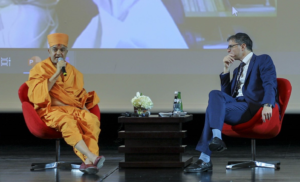
SS: So is there a message here about India’s spirituality and leadership playing a role in promoting global harmony and peace?
BS: One hundred per cent! It’s a message for the whole of humanity. And it’s not just India. It’s also the rulers of this nation. It’s made in India and made in UAE. Of course, it’s based on Indian values, the love and the effort of Indian artisans and BAPS volunteers and the guidance of Mahant Swami Maharaj. But it’s also the graciousness of this nation. It’s a great message to the world, that harmony is the way forward, and without it, perhaps we have no future. That’s why the mandir has been also sublimed as BAPS Hindu Mandir, a spiritual oasis for global harmony, and its people together, from all walks, all countries, and all religions, actually created this harmony.
When you come into the mandir, we’ve created this huge sand dune, that’s where people are received. And the first exhibit you see is the wall of harmony. It’s 3D printed. It’s been gifted to us by the Bohra Muslim community. You go to the Orientation Hall, and that’s been gifted by the Parsi community. This entire process has come about because Pramukh Swami talked about bringing countries, cultures together.
SS: Can you please tell us about the mandir and the seven shikhars representing the seven Emirati States?
BS: The mandir is set in a desert, which is right in the middle of Dubai and Abu Dhabi, in Abu Mureikhah. The buildings around the temple are monolithic because a geological expert advised us that ‘because this is in the desert, you will get sandstorms, your temple will be carved. So you will have to have buildings strategically placed around the temple to actually soften the storm.’
So you had to have buildings, which will actually protect the mandir, and those buildings will also have facilities. One of the ideas which has come for the building is monolithic buildings, which are modern and minimalistic. That idea came to me, and I’ll say as a child, I was always inspired by Stonehenge. Getting monolithic makes it ancient, in my opinion. So when we sat down with the designers, we said we want monolithic buildings around. Then outside the saras scape, there’s scape inside from where the waters get together, Ganga, Yamuna and Saraswathi, that’s where we will have the oasis where all the gardens will grow. And that’s where the mandir comes in. So from monolithic buildings to the three rivers, then coming down to the seven shikhars.
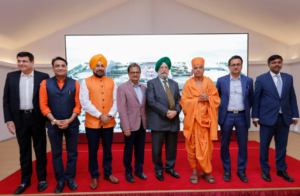
That is clearly a way of expressing our gratitude to the seven emirates because all of them collectively have a role in welcoming the mandir. It also talks about Hindu unity, as well. So in the first shikhar on the left is Shiva shikhar, where you have the entire Shiva parivar. Lord Shiva, Parvatiji, Ganapathiji and Karthikeyaji. The second shikar will have Jagannadhji. The murthi of Jagannadhji is made out of wood in the traditional way. The third shikhar will have Radha Krishna, then the fourth in the centre will be Akshar-Purushottam, Swaminarayan Maharaj with Gunatitanand Swami. The fifth will have Tirupati Balaji and Padmavathiji, and in the sixth, we have Ayyappaswamiji. The seventh, that’s the first shikhar on the right, we have Ram parivar, Bhagwan Shri Ram, Sitaji, and Lakshmanji. So these are the all the main deities in different shikhars. They are being placed in a beautiful way.
Around the shikhars, we have the entire Ramayan carved where Lord Rama is there. We have the entire Shiv Puran carved outside the Shiva shikhar. Around Lord Krishna shikhar, we have the Gita, the Bhagavatham, and the Mahabharat all these hand-carved. We have Jagannadhji’s yatra completely carved. And then we have these stories and episodes from the Swaminarayan’s life carved around his shikhar. Then Tirupati Balaji’s life, Ayyappaswamy’s life. The carvings are actually encyclopaedic.
One more step that we’ve taken is to express the Vasudeva Kutumbakam – that’s the bhavana. Pramukh Swami always expressed that. Mahant Swami always says that harmony is God’s virtue. Wherever there is harmony, God resides. And whatever you ask from God, he only gives if you are harmonious. It becomes very important as we move ahead. So we decided to take around 14 incidents from ancient civilisations which talked about harmony and friendship.
So we have an incident from Arabic culture of King Sulaiman carved. We have a beautiful story from the Mayan culture, of the two aztecs who are constantly fighting. The moral of the story is that in friendship, we flourish, in war, we perish. We have a story from Chinese civilisation, and the Egyptian civilisation is almost done in the form of hieroglyphics. So all that has been carved on the temple, and then around the temple, we have an assembly hall that caters to all our cultural needs. We have a library, a majlis (sitting room) for the people. We have a community centre and a food court. Then, inspired from the Varanasi ghats, we have a beautiful ghat where the Ganga River passes, where you can sit and contemplate.

SS: It seems like a confluence of all different messages of various religions and ideas. So, ten years from now, what’s your hope for the message that this temple will bring to the region?
BS: Not just now, not just after ten years, but even after 1000 years, this place of worship, or I believe any place of worship, should give the message of harmony, whether it’s harmony in the family, harmony in community, harmony within own self, harmony with God, and harmony amongst ourselves, between countries. That’s the only message it should give. And that is the message of what Indian culture and Hinduism are all about. When I talk to you about harmony, you don’t have to force yourself to believe in harmony. You believe because of nature. We are in harmony with nature, with the sun, with the moon, with the forests, with the waters. We worship them. So I believe the single message should go is global harmony, beginning with personal harmony.
SS: As the mandir is finally coming to fruition, what do you think Pujya Pramukh Swami would be saying, looking down from the heavens?
BS: It’s too overwhelming. I know he’ll be happy. I’ll I see his smile. From one end of the sky to the other end. I feel it. It’s not about eloquence or putting words together. It’s about feeling it. I feel him now. And I believe those whom you love, never leave you. Personally, I feel his love through Mahant Swami, and everybody. This was perhaps the most daunting task, and everybody has helped. If I said that we did it, it’s not true. This temple is too big for any individual or any one organisation, no way. It’s the will of God and the grace of Guru that the stars have a light. So everybody has helped, and I feel his smile. It’s not about seeing him smile. I feel it and it cuts across the skies.
SS: You’ve been involved in many of the most significant projects undertaken by BAPS. What’s next for you after the completion of this project?
BS: Pramukh Swami was asked the same question by Dr Subramanyam, who had actually operated on his heart. He was the bypass surgeon, and the only one who actually physically held his heart! He came down to see the Delhi Akshardham and he was so happy and then out of the blue he asked Swami, ‘so what’s your next project’. And he said, very smilingly, ‘bhajan bhakti’ and then added, ‘amne toh Bhagwan Swaminarayane kayami project aapyo che’. God has given me a project which is permanent, the project of peace, to bring more peace. And, then he said, ‘vachma aava mandiro bani Jaay che’. And as a by-product the mandirs have been built.
Like I said, I was always inspired by him, his words, what he did and how he carried himself. I believe this was not something that I have done. And this is the truth. It’s not about me doing something else. It’s about him guiding me to do something else. It’s very clear. And why do I say that? If I ask you to jump, how high can you jump? Two feet? three feet? If you’re a high jumper, maybe seven feet. If you’re a pole vaulter, maybe 18-20 feet. But if you jump and you land on the moon, then you need to admit to yourself that these are not your legs that carried you. You can’t be fooled. I know I didn’t do it, very clearly. It happened. Everybody has helped. It’s what he guides, how he guides, and what we all do together.
On the horizon, the King of Bahrain has already allotted us another land in Bahrain. But at the end of the day, whatever our Guru wishes. It’s not something that I feel that I have to do. It’s whatever he guides.
Mrunal Thakur on Dhamaka, experience of working with Kartik Aaryan,…
Nushrratt Bharuccha on Chhorii, pressure of comparison with Lapachhapi, upcoming…
Abhimanyu Dassani on Meenakshi Sundareshwar, how his mom Bhagyashree reacted…